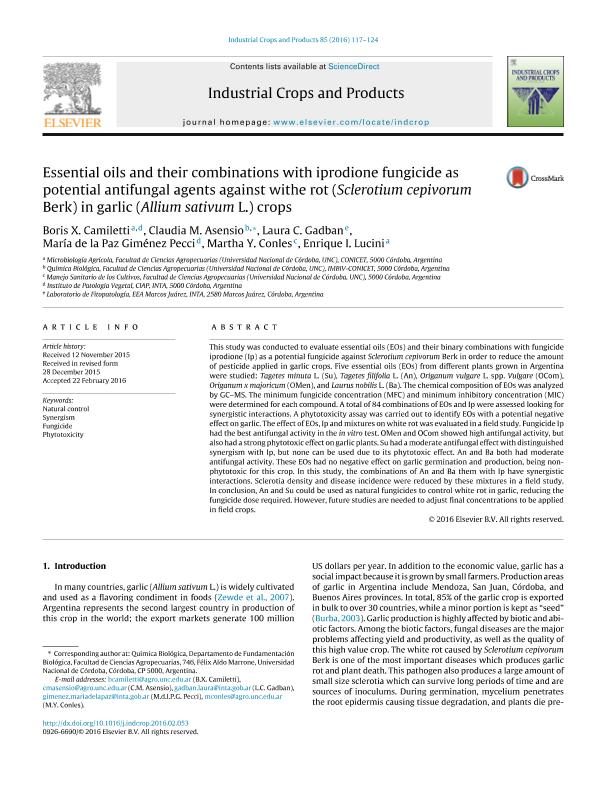Artículo
Essential oils and their combinations with iprodionefungicide as potential antifungal agents against withe rot (Sclerotium cepivorum Berk) in garlic (Allium sativum L.) crops
Camiletti, Boris Xavier ; Asensio, Claudia Mariana
; Asensio, Claudia Mariana ; Gadbán, Laura Carolina; Pecci, María de la Paz; Conles, Martha Yolanda; Lucini, Enrique Iván
; Gadbán, Laura Carolina; Pecci, María de la Paz; Conles, Martha Yolanda; Lucini, Enrique Iván
 ; Asensio, Claudia Mariana
; Asensio, Claudia Mariana ; Gadbán, Laura Carolina; Pecci, María de la Paz; Conles, Martha Yolanda; Lucini, Enrique Iván
; Gadbán, Laura Carolina; Pecci, María de la Paz; Conles, Martha Yolanda; Lucini, Enrique Iván
Fecha de publicación:
02/2016
Editorial:
Elsevier Science
Revista:
Industrial Crops and Products
ISSN:
0926-6690
Idioma:
Inglés
Tipo de recurso:
Artículo publicado
Clasificación temática:
Resumen
This study was conducted to evaluate essential oils (EOs) and their binary combinations with fungicideiprodione (Ip) as a potential fungicide against Sclerotium cepivorum Berk in order to reduce the amountof pesticide applied in garlic crops. Five essential oils (EOs) from different plants grown in Argentinawere studied: Tagetes minuta L. (Su), Tagetes filifolia L. (An), Origanum vulgare L. spp. Vulgare (OCom),Origanum x majoricum (OMen), and Laurus nobilis L. (Ba). The chemical composition of EOs was analyzedby GC?MS. The minimum fungicide concentration (MFC) and minimum inhibitory concentration (MIC)were determined for each compound. A total of 84 combinations of EOs and Ip were assessed looking forsynergistic interactions. A phytotoxicity assay was carried out to identify EOs with a potential negativeeffect on garlic. The effect of EOs, Ip and mixtures on white rot was evaluated in a field study. Fungicide Iphad the best antifungal activity in the in vitro test. OMen and OCom showed high antifungal activity, butalso had a strong phytotoxic effect on garlic plants. Su had a moderate antifungal effect with distinguishedsynergism with Ip, but none can be used due to its phytotoxic effect. An and Ba both had moderateantifungal activity. These EOs had no negative effect on garlic germination and production, being non-phytotoxic for this crop. In this study, the combinations of An and Ba them with Ip have synergisticinteractions. Sclerotia density and disease incidence were reduced by these mixtures in a field study.In conclusion, An and Su could be used as natural fungicides to control white rot in garlic, reducing thefungicide dose required. However, future studies are needed to adjust final concentrations to be appliedin field crops.
Palabras clave:
NATURAL CONTROL
,
SYNERGISM
,
FUNGICIDE
,
PHYTOTOXICITY
Archivos asociados
Licencia
Identificadores
Colecciones
Articulos(CCT - CORDOBA)
Articulos de CTRO.CIENTIFICO TECNOL.CONICET - CORDOBA
Articulos de CTRO.CIENTIFICO TECNOL.CONICET - CORDOBA
Citación
Camiletti, Boris Xavier; Asensio, Claudia Mariana; Gadbán, Laura Carolina; Pecci, María de la Paz; Conles, Martha Yolanda; et al.; Essential oils and their combinations with iprodionefungicide as potential antifungal agents against withe rot (Sclerotium cepivorum Berk) in garlic (Allium sativum L.) crops; Elsevier Science; Industrial Crops and Products; 85; 2-2016; 117-124
Compartir
Altmétricas



